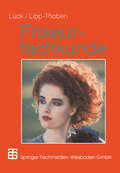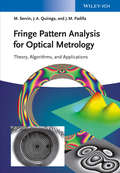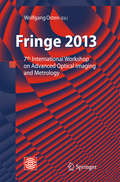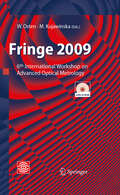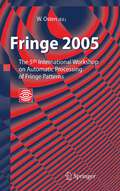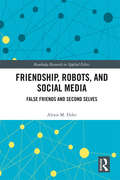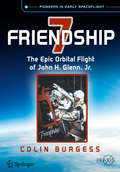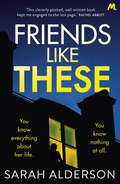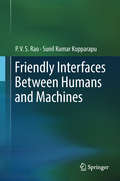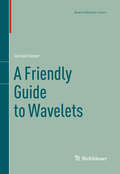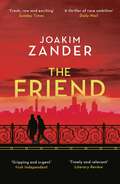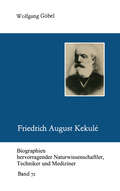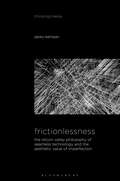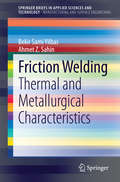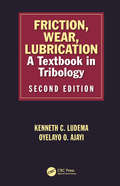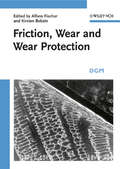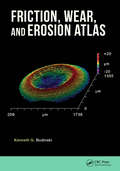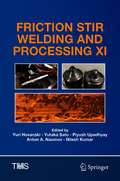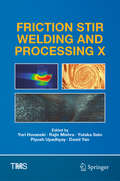- Table View
- List View
Friseurfachkunde
by Dieter Lück Hanna Lipp-ThobenDas modern gestaltete, schülergemäße Lehrbuch enthält den Lernstoff für alle Berufsausbildungsstufen. Durch übersichtliche Gliederung, klare Darstellung und handlungsorientiertes Vorgehen werden Zusammenhänge aufgezeigt. Reiche Bebilderung, gezielte Fragen und Lernkontrollen dienen der Wiederholung und Festigung. Die Abschnitte wurden farbiger und besser bebildert, der Text erweitert.
Fringe Pattern Analysis for Optical Metrology: Theory, Algorithms, and Applications
by Manuel Servin J. Antonio Quiroga Moises PadillaThe main objective of this book is to present the basic theoretical principles and practical applications for the classical interferometric techniques and the most advanced methods in the field of modern fringe pattern analysis applied to optical metrology. A major novelty of this work is the presentation of a unified theoretical framework based on the Fourier description of phase shifting interferometry using the Frequency Transfer Function (FTF) along with the theory of Stochastic Process for the straightforward analysis and synthesis of phase shifting algorithms with desired properties such as spectral response, detuning and signal-to-noise robustness, harmonic rejection, etc.
Fringe Pattern Analysis for Optical Metrology: Theory, Algorithms, and Applications
by Manuel Servin J. Antonio Quiroga Moises PadillaThe main objective of this book is to present the basic theoretical principles and practical applications for the classical interferometric techniques and the most advanced methods in the field of modern fringe pattern analysis applied to optical metrology. A major novelty of this work is the presentation of a unified theoretical framework based on the Fourier description of phase shifting interferometry using the Frequency Transfer Function (FTF) along with the theory of Stochastic Process for the straightforward analysis and synthesis of phase shifting algorithms with desired properties such as spectral response, detuning and signal-to-noise robustness, harmonic rejection, etc.
Fringe 2013: 7th International Workshop on Advanced Optical Imaging and Metrology
by Wolfgang OstenIn continuation of the FRINGE Workshop Series this Proceeding contains all contributions presented at the 7. International Workshop on Advanced Optical Imaging and Metrology. The FRINGE Workshop Series is dedicated to the presentation, discussion and dissemination of recent results in Optical Imaging and Metrology. Topics of particular interest for the 7. Workshop are: - New methods and tools for the generation, acquisition, processing, and evaluation of data in Optical Imaging and Metrology (digital wavefront engineering, computational imaging, model-based reconstruction, compressed sensing, inverse problems solution) - Application-driven technologies in Optical Imaging and Metrology (high-resolution, adaptive, active, robust, reliable, flexible, in-line, real-time) - High-dynamic range solutions in Optical Imaging and Metrology (from macro to nano) - Hybrid technologies in Optical Imaging and Metrology (hybrid optics, sensor and data fusion, model-based solutions, multimodality) - New optical sensors, imaging and measurement systems (integrated, miniaturized, in-line, real-time, traceable, remote) Special emphasis is put on new strategies, taking into account the active combination of physical modeling, computer aided simulation and experimental data acquisition. In particular attention is directed towards new approaches for the extension of existing resolution limits that open the gates to wide-scale metrology, ranging from macro to nano, by considering dynamic changes and using advanced optical imaging and sensor systems.
Fringe 2009: 6th International Workshop on Advanced Optical Metrology
by Wolfgang Osten Malgorzata Kujawinska21 years ago it was a joint idea with Hans Rottenkolber to organize a workshop dedicated to the discussion of the latest results in the automatic processing of fringe patterns. This idea was promoted by the insight that automatic and high precision phase measurement techniques will play a key role in all future industrial and scientific applications of optical metrology. A couple of months later more than 50 specialists from East and West met in East Berlin, the capital of the former GDR, to spend 3 days with the discussion of new principles of fringe processing. In the stimulating atmoshere the idea was born to repeat the workshop and to organize the meeting in an olympic schedule. And thus meanwhile 20 years have been passed and we have today Fringe number six. However, such a workshop takes place in a dynamic environment. Therefore the main topics of the previous events were always adapted to the most interesting subjects of the new period. In 1993 the workshop took place in Bremen and was dedicated to new principles of optical shape measurement, setup calibration, phase unwrapping and nondestructive testing, while in 1997 new approaches in multi-sensor metrology, active measurement strategies and hybrid processing technologies played a central role. 2001, the first meeting in the 21st century, was focused to optical methods for micromeasurements, hybrid measurement technologies and new sensor solutions for industrial inspection.
Fringe 2005: The 5th International Workshop on Automatic Processing of Finge Patterns
by Wolfgang OstenIn 1989 the time was hot to create a workshop series dedicated to the dicussion of the latest results in the automatic processing of fringe patterns. This idea was promoted by the insight that automatic and high precision phase measurement techniques will play a key role in all future industrial applications of optical metrology. However, such a workshop must take place in a dynamic environment. The- fore the main topics of the previous events were always adapted to the most interesting subjects of the new period. In 1993 new prin- ples of optical shape measurement, setup calibration, phase unwr- ping and nondestructive testing were the focus of discussion, while in 1997 new approaches in multi-sensor metrology, active measu- ment strategies and hybrid processing technologies played a central role. 2001, the first meeting in the 21st century, was dedicated to - tical methods for micromeasurements, hybrid measurement te- nologies and new sensor solutions for industrial inspection. The fifth workshop takes place in Stuttgart, the capital of the state of Baden- Württemberg and the centre of a region with a long and remarkable tradition in engineering. Thus after Berlin 1989, Bremen 1993, 1997 and 2001, Stuttgart is the third Fringe city where international - perts will meet each other to share new ideas and concepts in optical metrology. This volume contains the papers presented during FRINGE 2005.
Friendship, Robots, and Social Media: False Friends and Second Selves (Routledge Research in Applied Ethics)
by Alexis M. ElderVarious emerging technologies, from social robotics to social media, appeal to our desire for social interactions, while avoiding some of the risks and costs of face-to-face human interaction. But can they offer us real friendship? In this book, Alexis Elder outlines a theory of friendship drawing on Aristotle and contemporary work on social ontology, and then uses it to evaluate the real value of social robotics and emerging social technologies. In the first part of the book Elder develops a robust and rigorous ontology of friendship: what it is, how it functions, what harms it, and how it relates to familiar ethical and philosophical questions about character, value, and well-being. In Part II she applies this ontology to emerging trends in social robotics and human-robot interaction, including robotic companions for lonely seniors, therapeutic robots used to teach social skills to children on the autism spectrum, and companionate robots currently being developed for consumer markets. Elder articulates the moral hazards presented by these robots, while at the same time acknowledging their real and measurable benefits. In the final section she shifts her focus to connections between real people, especially those enabled by social media. Arguing against critics who have charged that these new communication technologies are weakening our social connections, Elder explores ways in which text messaging, video chats, Facebook, and Snapchat are enabling us to develop, sustain, and enrich our friendship in new and meaningful ways.
Friendship, Robots, and Social Media: False Friends and Second Selves (Routledge Research in Applied Ethics)
by Alexis M. ElderVarious emerging technologies, from social robotics to social media, appeal to our desire for social interactions, while avoiding some of the risks and costs of face-to-face human interaction. But can they offer us real friendship? In this book, Alexis Elder outlines a theory of friendship drawing on Aristotle and contemporary work on social ontology, and then uses it to evaluate the real value of social robotics and emerging social technologies. In the first part of the book Elder develops a robust and rigorous ontology of friendship: what it is, how it functions, what harms it, and how it relates to familiar ethical and philosophical questions about character, value, and well-being. In Part II she applies this ontology to emerging trends in social robotics and human-robot interaction, including robotic companions for lonely seniors, therapeutic robots used to teach social skills to children on the autism spectrum, and companionate robots currently being developed for consumer markets. Elder articulates the moral hazards presented by these robots, while at the same time acknowledging their real and measurable benefits. In the final section she shifts her focus to connections between real people, especially those enabled by social media. Arguing against critics who have charged that these new communication technologies are weakening our social connections, Elder explores ways in which text messaging, video chats, Facebook, and Snapchat are enabling us to develop, sustain, and enrich our friendship in new and meaningful ways.
Friendship 7: The Epic Orbital Flight of John H. Glenn, Jr. (Springer Praxis Books)
by Colin BurgessIn this spellbinding account of an historic but troubled orbital mission, noted space historian Colin Burgess takes us back to an electrifying time in American history, when intrepid pioneers were launched atop notoriously unreliable rockets at the very dawn of human space exploration.A nation proudly and collectively came to a standstill on the day this mission flew; a day that will be forever enshrined in American spaceflight history. On the morning of February 20, 1962, following months of frustrating delays, a Marine Corps war hero and test pilot named John Glenn finally blazed a path into orbit aboard a compact capsule named Friendship 7.The book’s tension-filled narrative faithfully unfolds through contemporary reports and the personal recollections of astronaut John Glenn, along with those closest to the Friendship 7 story, revealing previously unknown facts behind one of America’s most ambitious and memorable pioneering space missions.Friendship 7.The book’s tension-filled narrative faithfully unfolds through contemporary reports and the personal recollections of astronaut John Glenn, along with those closest to the Friendship 7 story, revealing previously unknown facts behind one of America’s most ambitious and memorable pioneering space missions.Friendship 7 story, revealing previously unknown facts behind one of America’s most ambitious and memorable pioneering space missions.
Friends Like These: A gripping psychological thriller with a shocking twist
by Sarah AldersonAs addictive as THE SILENT PATIENT, as gripping as THE GIRL BEFORE.One wrong click can ruin your life...Lizzie hasn't thought about her colleague Becca in years - not since the accident. Then Becca's ex-boyfriend turns up on Tinder, and Lizzie's curiosity is sparked. It looks like Becca hasn't changed. She's still all over social media: #perfectlife, #perfectjob, #blessed. Lizzie can't resist a dig. But she sends her mean comment to Becca by mistake...She's about to find out you can't always believe what you see online. And that with friends like Becca, you don't need enemies... A gripping read with a twist you won't see coming - the perfect thriller for the digital age.Readers love FRIENDS LIKE THESE'FABULOUS. Best psychological thriller I've read.''Absolutely loved every second of it and didn't want it to end.''Can't wait for her next book. Just blown away.''This was the best book I have read all year. Absolutely amazing. It kept me up ALL night because I just couldn't put it down.''More than a 5 star, completely original, scary, tense, thrilling, and chilling. Loved, loved, loved, loved.'
Friendly Interfaces Between Humans and Machines
by P. V. Rao Sunil Kumar KopparapuThis book discusses human–machine interactions, specifically focusing on making them as natural as human–human interaction. It is based on the premise that to get the right connect between human and machines, it is essential to understand not only the behavior of the person interacting with the machine, but also the limitations of the technology. Firstly, the authors review the evolution of language as a spontaneous, natural phenomenon in the overall scheme of the evolutionary development of living beings. They then go on to examine the possible approaches to understanding and representing the meaning and the common aspects of human–human and human–machine interactions, and introduce the keyconcept-keyword (also called minimal parsing) approach as a convenient and realistic way to implement usable human–machine interface (HMI) systems. For researchers looking for practical approaches, way beyond the realms of theory, this book is a must read.
A Friendly Guide to Wavelets (Modern Birkhäuser Classics)
by Gerald KaiserThis volume is designed as a textbook for an introductory course on wavelet analysis and time-frequency analysis aimed at graduate students or advanced undergraduates in science and engineering. It can also be used as a self-study or reference book by practicing researchers in signal analysis and related areas. Since the expected audience is not presumed to have a high level of mathematical background, much of the needed analytical machinery is developed from the beginning. The only prerequisites for the first eight chapters are matrix theory, Fourier series, and Fourier integral transforms. Each of these chapters ends with a set of straightforward exercises designed to drive home the concepts just covered, and the many graphics should further facilitate absorption.
Friend Request: The most addictive psychological thriller you'll read this year
by Laura Marshall***THE SUNDAY TIMES & NO.1 EBOOK BESTSELLER***'Twisty and gripping' Erin Kelly'I read it in one go' Marian Keyes'I loved it' Rachel Abbott Don't miss Laura Marshall's addictive new thriller, MY HUSBAND'S KILLER. Available now!*****Maria Weston wants to be friends with me Maybe that had been the problem all along: Maria Weston had wanted to be friends with me, but I let her down.She's been hovering at the edge of my consciousness for all of my adult life, although I've been good at keeping her out, just a blurred shadow in the corner of my eye, almost but not quite out of sight.Maria Weston wants to be friends. But Maria Weston has been dead for more than twenty-five years. *****THE ADDICTIVE PSYCHOLOGICAL THRILLER THAT EVERYONE'S RAVING ABOUT 'The twist is genuinely unexpected . . . This is an obvious choice if you enjoyed The Girl on the Train' Independent'I couldn't put it down!' Jenny Blackhurst, author of The Foster Child'A mystery with a genius premise' Stylist'A devour-in-one-sitting must' Heat'Tightly plotted, and with a fabulous twist' Sunday Mirror'Gripping . . . loved it from start to finish' Goodreads Reviewer'Twisty and gripping . . . You must read this!' Emma Kavanagh, author of Falling'Twists and turns and real life scenarios make this a fantastic thriller' Amazon Reviewer
The Friend
by Joakim ZanderA gripping international thriller, perfect for fans of Homeland. Trust. Betrayal. Conspiracy. Jacob Seger is a trainee diplomat who dreams of changing the world. But on his first posting, in Beirut, he meets a handsome stranger at a party and is swept up in a passionate, obsessive, affair. His relationship with Yassim eclipses everything – until one day Jacob recognises his own face in the newspaper. He is wanted on terrorism charges. Has Yassim set him up? Is he now a pawn in a murderous plot? Jacob is being pulled into a dangerous and complicated game. He needs to learn the rules, and escape Beirut – and he needs to do it fast. At once a moving love story and a gripping adventure, The Friend is an intelligent, urgent thriller that casts light on the dark threats facing the world today. WORLDWIDE REVIEWS FOR JOAKIM ZANDER: 'Fresh, raw and exciting' Sunday Times (UK). 'A thriller of rare ambition' Daily Mail (UK). 'Gripping and urgent' Irish Independent (UK). 'Timely and relevant' Literary Review (UK). 'Both forceful and subtle... Powerfully orchestrated tension set against a strong dose of social commentary' Independent (UK). 'An absorbing thriller in a complex world of spies, politics, terrorism and assassination... Excellent' The Times (UK). 'A multi-layered thriller full of style, drive and immediacy' Göteborgs-Posten (Sweden). 'Wonderfully written... A superb thriller' Metro (Croatia). 'Intrigue, action and adrenaline mixed to perfection' Librería Reconquista (Spain). 'A terrific page-turner rich with complex conflicts and a big, meaty, chillingly credible conspiracy' Chris Pavone (USA). 'A riveting thriller with a great plot. What more can you ask for?' Lokalavisen (Denmark). 'An explosive, thrilling dance fuelled by authenticity' Il Giornale (Italy). 'A multi-layered, action-packed thriller' Dorstener Zeitung (Germany).
Friedrich Wilhelm Herschel (Biographien hervorragender Naturwissenschaftler, Techniker und Mediziner #89)
by Jürgen HamelFriedrich August Kekulé (Biographien hevorragender Naturwissenschaftler, Techniker und Mediziner #72)
by Wolfgang GöbelFrictionlessness: The Silicon Valley Philosophy of Seamless Technology and the Aesthetic Value of Imperfection (Thinking Media)
by Jakko KemperFrictionlessness provides an examination of the environmentally destructive digital design philosophy of "frictionlessness" and the critical significance of a technological aesthetic of imperfection.If there is one thing that defines digital consumer technologies today, it is that they are designed to feel frictionless. From smart technologies to cloud computing, from from one-click shopping to the promise of seamless streaming-digital technology is framed to host ever-faster operations while receding increasingly into the background of perception. The environmental costs of this fetishization of frictionlessness are enormous and unevenly distributed; the frictionless experience of the end user tends to be supported by opaque networks of exploited labor and extracted resources that disproportionately impact the Global South. This situation marks an urgent need for alternate, less destructive aesthetic relations to technology. As such, this book examines imperfection, as an aesthetic concept that highlights existential conditions of finitude and fragility, as a particularly powerful counterweight to the dominant digital design philosophy of frictionlessness.While frictionlessness aims to draw the user's perception away from the exploitative and destructive conditions of digital production, imperfection forms an aesthetic source of friction that alerts users to the fragile nature of technology and the finite resources on which it relies. These arguments are elaborated through a close reading of three technological objects-a video game that was programmed to expire, an audiovisual performance that laments the fate of disused technology and a collection of music albums that dramatize a techno-cultural logic of relentless consumerism. Together, these case studies underline the value of technological aesthetics of imperfection and point to the need for a renewed ethics of care in relation to technology.
Frictionlessness: The Silicon Valley Philosophy of Seamless Technology and the Aesthetic Value of Imperfection (Thinking Media)
by Jakko KemperFrictionlessness provides an examination of the environmentally destructive digital design philosophy of "frictionlessness" and the critical significance of a technological aesthetic of imperfection.If there is one thing that defines digital consumer technologies today, it is that they are designed to feel frictionless. From smart technologies to cloud computing, from from one-click shopping to the promise of seamless streaming-digital technology is framed to host ever-faster operations while receding increasingly into the background of perception. The environmental costs of this fetishization of frictionlessness are enormous and unevenly distributed; the frictionless experience of the end user tends to be supported by opaque networks of exploited labor and extracted resources that disproportionately impact the Global South. This situation marks an urgent need for alternate, less destructive aesthetic relations to technology. As such, this book examines imperfection, as an aesthetic concept that highlights existential conditions of finitude and fragility, as a particularly powerful counterweight to the dominant digital design philosophy of frictionlessness.While frictionlessness aims to draw the user's perception away from the exploitative and destructive conditions of digital production, imperfection forms an aesthetic source of friction that alerts users to the fragile nature of technology and the finite resources on which it relies. These arguments are elaborated through a close reading of three technological objects-a video game that was programmed to expire, an audiovisual performance that laments the fate of disused technology and a collection of music albums that dramatize a techno-cultural logic of relentless consumerism. Together, these case studies underline the value of technological aesthetics of imperfection and point to the need for a renewed ethics of care in relation to technology.
Friction Welding: Thermal and Metallurgical Characteristics (SpringerBriefs in Applied Sciences and Technology)
by Bekir Sami Yilbas Ahmet Z. SahinThis book provides insight into the thermal analysis of friction welding incorporating welding parameters such as external, duration, breaking load, and material properties. The morphological and metallurgical changes associated with the resulting weld sites are analysed using characterization methods such as electron scanning microscope, energy dispersive spectroscopy, X-ray Diffraction, and Nuclear reaction analysis.
Friction, Wear, Lubrication: A Textbook in Tribology, Second Edition
by Kenneth C Ludema Layo AjayiThe second edition of a bestseller, this book introduces tribology in a way that builds students’ knowledge and understanding. It includes expanded information on topics such as surface characterization as well as recent advances in the field. The book provides additional descriptions of common testing methods, including diagrams and surface texturing for enhanced lubrication, and more information on rolling element bearings. It also explores surface profile characterization and elastic plastic contact mechanics including wavy surface contact, rough surface contact models, friction and wear plowing models, and thermodynamic analysis of friction.
Friction, Wear, Lubrication: A Textbook in Tribology, Second Edition
by Kenneth C Ludema Layo AjayiThe second edition of a bestseller, this book introduces tribology in a way that builds students’ knowledge and understanding. It includes expanded information on topics such as surface characterization as well as recent advances in the field. The book provides additional descriptions of common testing methods, including diagrams and surface texturing for enhanced lubrication, and more information on rolling element bearings. It also explores surface profile characterization and elastic plastic contact mechanics including wavy surface contact, rough surface contact models, friction and wear plowing models, and thermodynamic analysis of friction.
Friction, Wear and Wear Protection
by Alfons Fischer Kirsten BobzinThe proceedings collect invited and contributed papers from more than 150 scientists and engineers worldwide which provide an up-to-date overview of the current research on friction and wear, including new systematic approaches as well as innovative technical solutions.
Friction, Wear, and Erosion Atlas
by Kenneth G. BudinskiFriction, wear, and erosion are major issues in mechanical engineering and materials science, resulting in major costs to businesses operating in the automotive, biomedical, petroleum/oil/gas, and structural engineering industries. The good news is, by understanding what friction, wear, or erosion mode predominates in a mechanism or device, you can
Friction Stir Welding and Processing XI (The Minerals, Metals & Materials Series)
by Yuri Hovanski Yutaka Sato Piyush Upadhyay Anton A. Naumov Nilesh KumarThis collection presents fundamentals and the current status of friction stir welding (FSW) and solid-state friction stir processing of materials, and provides researchers and engineers with an opportunity to review the current status of the friction stir related processes and discuss the future possibilities. Contributions cover various aspects of friction stir welding and processing including their derivative technologies. Topics include but are not limited to: • derivative technologies • high-temperature lightweight applications • industrial applications • dissimilar alloys and/or materials • controls and nondestructive examination • simulation • characterization
Friction Stir Welding and Processing X (The Minerals, Metals & Materials Series)
by Yuri Hovanski Rajiv Mishra Yutaka Sato Piyush Upadhyay David YanThis book is a compilation of the recent progress on friction stir technologies including high-temperature applications, industrial applications, dissimilar alloy/materials, lightweight alloys, simulation, control, characterization, and derivative technologies. The volume offers a current look at friction stir welding technology from application to characterization and from modeling to R&D. Contributions document advances in application, controls, and simulation of the friction stir process to aid researchers in seeing the current state-of-the-art.
